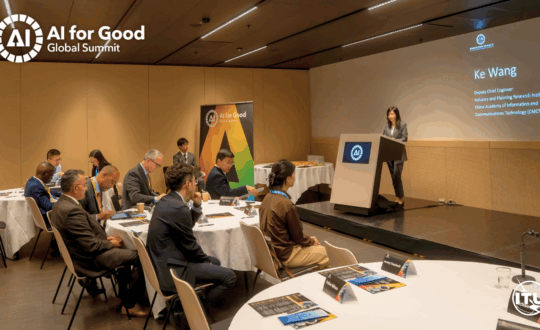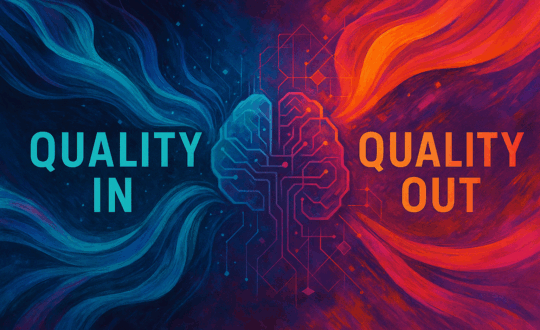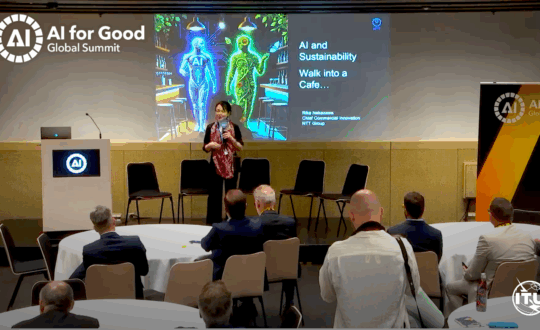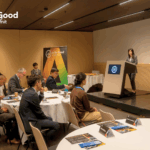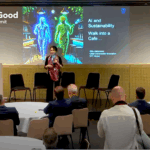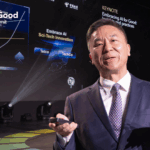During the Innovation Factory session focusing on accessible and affordable healthcare solutions on 25 February 2025, startups pitched groundbreaking ideas to improve health equity worldwide. The competition highlighted AI’s potential to bridge healthcare gaps, especially in underserved communities. This edition’s winner, RevolutionAIze, presented MAAP (Malnutrition Assessment & Action Plan), an innovative AI-powered solution that transforms child growth monitoring by accurately estimating height using just a smartphone image. Developed to address the alarming rates of undetected malnutrition, MAAP enables caregivers and health workers to assess child growth accurately, without the need for expensive equipment or medical expertise.
We spoke with Romita Ghosh, CEO of RevolutionAIze, about how AI can revolutionize public health and tackle one of the world’s most pressing challenges: child malnutrition.
Can you tell us about your winning solution?
Our winning solution, MAAP (Malnutrition Assessment & Action Plan), is an AI-powered child growth monitoring system that enables accurate height estimation from a single smartphone image. This breakthrough technology transforms the way we screen for malnutrition, track child development, and provide nutrition interventions – all without the need for expensive hardware or trained medical professionals.
With over 3.5 million severely malnourished children in India going unscreened, early detection is critical. MAAP leverages computer vision, machine learning, and a centralized database to generate real-time, geo-tagged growth data.
We’ve designed MAAP to be accessible, scalable, and impactful, particularly in low-resource settings where malnutrition is rampant. We’re also working with government agencies, NGOs, and healthcare providers to deploy MAAP in rural and underserved communities.
“By bridging the gap between AI and public health, MAAP is revolutionizing child growth tracking, reducing infant mortality, and ensuring better health outcomes,” explained Romita Ghosh.
Watch the full pitching session here:
The idea for MAAP was born out of a simple question: Why are so many malnourished children slipping through the cracks? It started when I won a hackathon supported by an NGO working in public health nutrition and the first 1000 days of a child’s life. We developed a technology that could estimate a child’s height using just a smartphone image. It felt like a breakthrough – something that could make a real difference.
But I knew that real-world solutions aren’t built in labs or competitions. So, I went to the ground, speaking to mothers, healthcare workers, and frontline caregivers to understand the actual challenges they faced. What I found was staggering. 61% of births in India still take place at home, often without trained healthcare professionals. In many communities, outsiders aren’t even allowed to touch newborns in the first few weeks of life, making standard growth monitoring nearly impossible. Healthcare workers, already stretched thin, were using broken or uncalibrated scales. Many had to manually record data, only for it to be lost or entered incorrectly. Malnutrition wasn’t just a health issue – it was an issue of access, awareness, and infrastructure.
That’s when I spoke to my co-founder, Nilashis Roy, a data scientist and fellow ICMR researcher, about everything I had seen. He pointed out something that changed everything: we could solve these challenges using camera vision and machine learning. The solution wasn’t to bring more hardware into already overburdened systems – it was to use something everyone already had: a smartphone.
Where are you from and what regions do you work in?
I am from India, a country where child malnutrition remains one of the most pressing public health challenges. Growing up and working here, I have seen firsthand how gaps in healthcare access, nutrition awareness, and monitoring systems leave millions of children vulnerable. This personal connection to the issue is what drives my work.
In the next couple of years, we aim to expand into Africa and other regions in Asia, where malnutrition remains a major challenge. By collaborating with local governments, international NGOs, and global health initiatives, we want to ensure that no child is left behind, no matter where they are born. The goal is to make AI-powered child growth monitoring accessible to every mother, every healthcare worker, and every child – regardless of geography or resources.
How can your solution help to solve global challenges?
Malnutrition is one of the biggest barriers to ending hunger. By enabling early detection of growth faltering, MAAP ensures timely nutritional interventions, helping children receive the right diet at the right time. Our AI-driven solution also correlates growth data with diet, providing personalized nutrition plans to prevent stunting and wasting. Malnutrition affects not just physical growth but also cognitive development and long-term health. MAAP helps by identifying malnourished children before it’s too late, ensuring early medical intervention and continuous monitoring. It also assists healthcare workers in tracking child growth efficiently, improving maternal and child health outcomes.
MAAP recognizes that poverty and malnutrition are deeply interconnected. Children in low-income households are at the highest risk of stunting, wasting, and undernutrition, as their families often struggle with food insecurity and limited access to healthcare. Nutrition poverty – the lack of essential nutrients due to poor diet – further exacerbates the cycle of poverty, leading to weaker immune systems, lower cognitive development, and reduced economic opportunities later in life.
Women, especially mothers and frontline health workers (ASHA & Anganwadi workers), play a crucial role in child nutrition. MAAP empowers them with a simple, tech-driven tool that enhances their ability to monitor, track, and act on child growth data – giving them more control over their children’s health while reducing the burden of manual record-keeping.
MAAP is an example of how AI and digital health can transform public health infrastructure. By integrating with national programs like Poshan Tracker 2.0, we are creating a centralized, data-driven approach to tackling malnutrition, which can be scaled to other regions and countries.
Malnutrition disproportionately affects children in rural, tribal, and low-income urban areas. Traditional methods of monitoring growth require physical infrastructure, trained personnel, and manual data collection – barriers that leave many children untracked. MAAP removes these barriers by leveraging smartphone-based AI, making accurate growth monitoring accessible, affordable, and scalable for even the most underserved communities.
Tackling malnutrition requires collaboration. We are working with government agencies, NGOs, academic institutions, and global health organizations to integrate MAAP into national nutrition programs and expand our reach beyond India into Africa and other parts of Asia.
What is your biggest challenge as an AI startup?
As an AI startup tackling malnutrition, our biggest challenge isn’t just the technology – it’s the ecosystem around it. One major hurdle is data quality and standardization. Malnutrition tracking has historically been plagued by inconsistent, incomplete, or manually recorded data, making it difficult to build robust AI models that work across diverse populations. We’ve tackled this by collecting real-world data from the ground, training our AI to work in different environments, and continuously refining our algorithms.
Secondly, to navigate the unclear regulatory landscape is challenging. AI in public health is still a new and evolving field, and while many are excited about its potential, there is no clear framework for validation and approval.
When we talk to health experts, NGOs, and government agencies, many ask about accuracy and clinical validation, which is fair. However, the challenge isn’t just proving that our AI works – it’s the fact that the regulators themselves don’t know how to categorize AI-driven diagnostics and predictive tools like ours. Traditional medical devices follow a clear path for approval, but an AI-powered growth monitoring solution like MAAP doesn’t fit neatly into existing regulations.
On one side, we face doubt from people unfamiliar with AI. On the other side, regulatory bodies have no established criteria for AI in preventive healthcare, making it difficult to get official recognition, which is crucial for scaling in public health programs. This regulatory gap slows down adoption, partnerships, and funding opportunities, as many institutions hesitate to implement AI-driven solutions without a formal framework.
“We are working closely with government agencies, research institutions, and public health policymakers to help shape these regulations. But for now, AI in healthcare remains a gray area, and startups like ours have to pioneer both the technology and the policy discussions around it,” said Gosh.
Why did you join the Innovation Factory Pitching Competition?
The AI for Good ecosystem provides an incredible opportunity to connect with global experts, policymakers, and organizations that share our vision. This competition was a chance to not only showcase our work but also find the right collaborators who can help us scale MAAP beyond India – into Africa, South Asia, and other regions facing a malnutrition crisis.
“I joined because I want to change the narrative around AI in public health. There is still skepticism and regulatory uncertainty around AI-driven diagnostics, and through this platform, I want to demonstrate how AI can be used responsibly, ethically, and effectively to tackle real-world health challenges,” concluded Ghosh.
With its victory at the AI for Good Innovation Factory, RevolutionAIze now moves forward to the Grand Finale at the AI for Good Global Summit in Geneva Switzerland, 8-11 July, where it will compete against other groundbreaking AI startups addressing global challenges. As they continue to expand beyond India, their mission to make child growth monitoring accessible and scalable is a testament to AI’s potential in advancing health equity.



